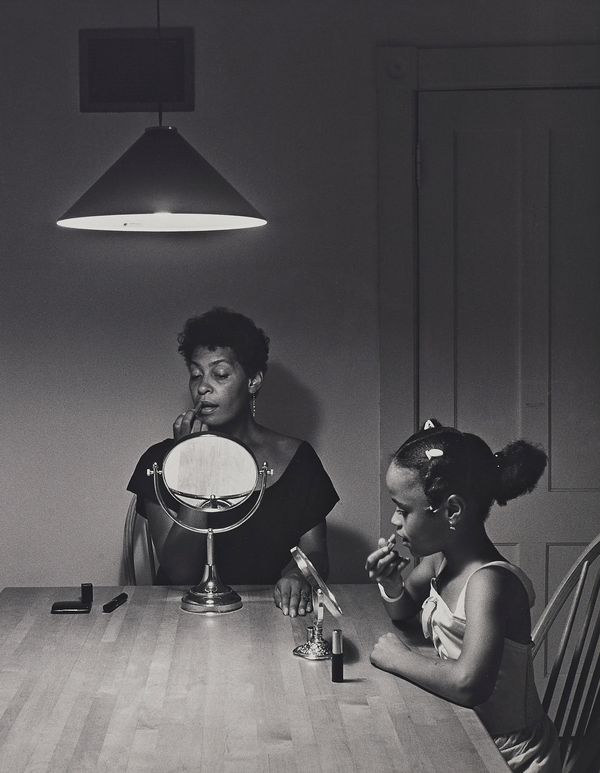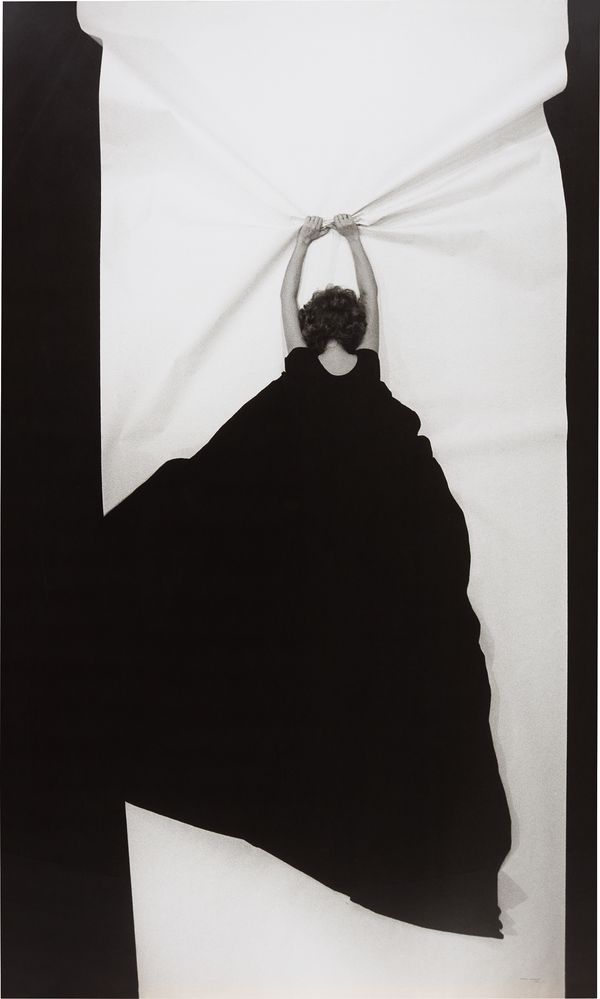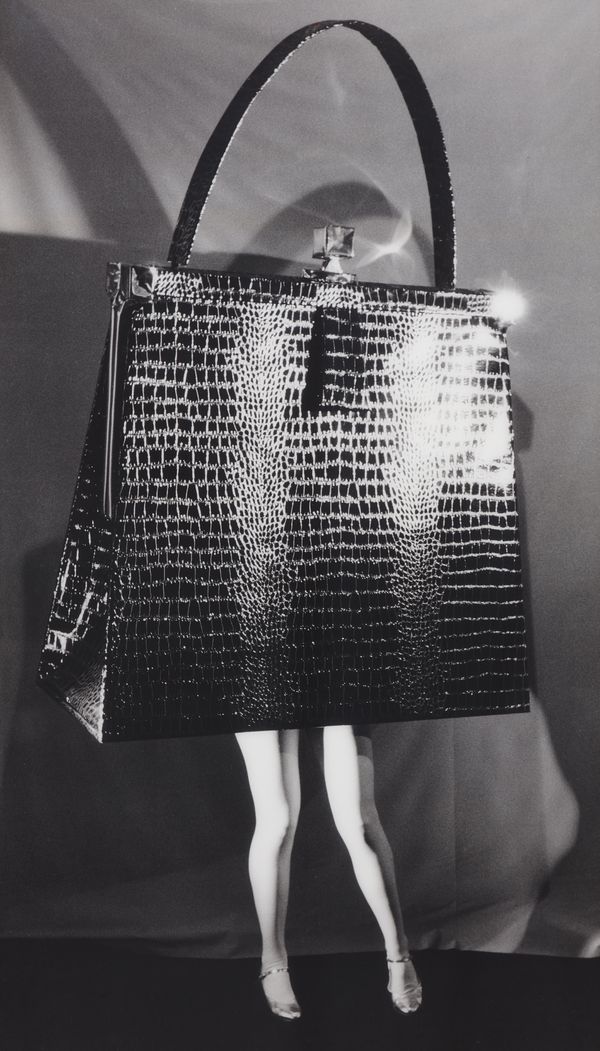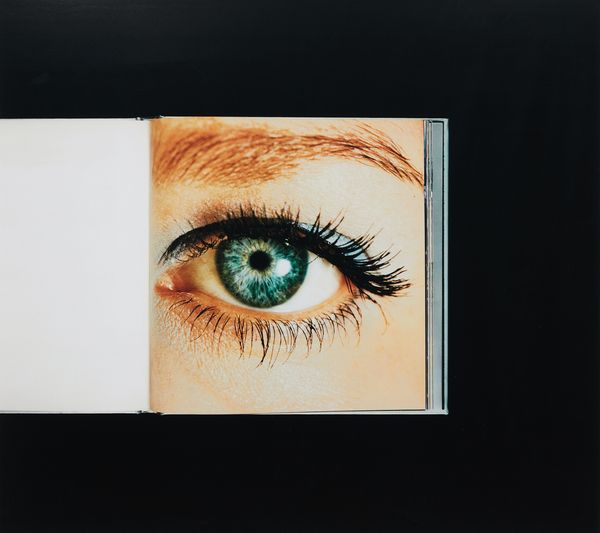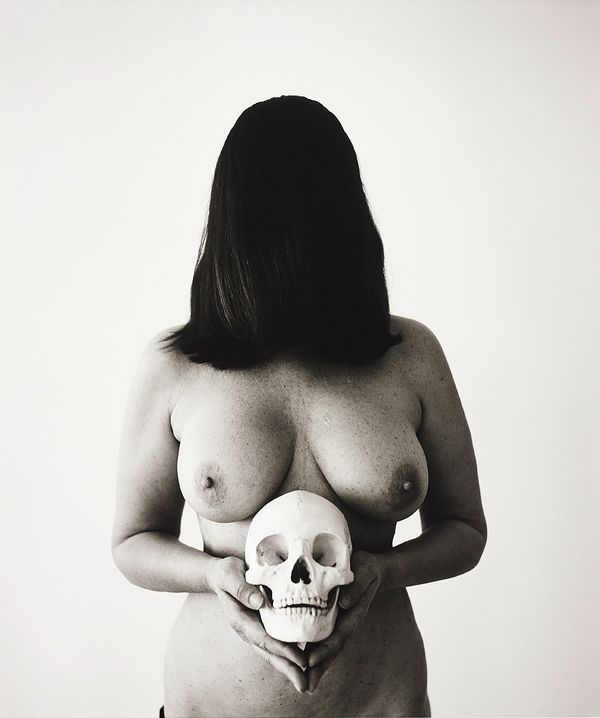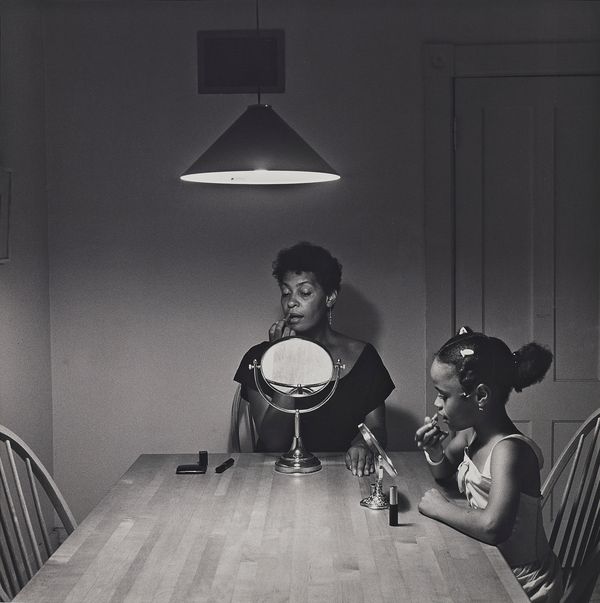Detail of Carrie Mae Weems Untitled (Woman and daughter with makeup) from Kitchen Table Series, 1990
The selection includes Helena Almeida's unique work exhibited in two solo shows; Laurie Simmons' gigantic alligator skin purse with legs appearing at auction for the first time in nearly a decade; Anne Collier's Eye (Enlargement of Color Negative), another of which resides at the Whitney Museum; Marina Abramovic's Self-Portrait With Skull appearing at auction for the first time; and Carrie Mae Weems' Untitled (Woman and daughter with makeup) from Kitchen Table Series, which has been in the same collection for over 20 years.
My work is my body; my body is my work.
— Helena Almeida
Helena Almeida Ponto de Fuga (Vanishing Point), 1982
In a large black dress that engulfs her body, a woman appears to be hanging mid-air, grasping a long white scroll of paper, set against a black background. Denied insight into the staging of this image, we see her dangling in front of us, resisting gravity. The woman is Helena Almeida. This is not self-portraiture, but a composition on the body and how it inhabits space. Made in 1982, the same year that Almeida participated in the Venice Biennale for the first time, Ponto de Fuga (Vanishing Point) is one of two works that share this title of which the variant was shown in Venice that summer.
Let's get to the image as quickly as possible, let's get to the message even faster, and let's find the scale to knock you over the head with the image and the message.
— Laurie Simmons
Laurie Simmons Walking Purse, 1988
This oversized black-and-white photograph of a gigantic alligator skin purse with legs is undeniably Laurie Simmons. Walking Purse, 1988, created for her seminal series Walking and Lying Object (1987-91), is one of only two instances where the object is worn by a real person. In the case of Walking Purse, Simmons has chosen an object that is a trope of femininity, drawing our attention to the signified role of women. An alligator skin purse references not only the cost of being a woman but also the influence of advertising and consumerism. Stereotypes of a woman and her handbag also come to mind: how she never leaves the house without it and how men find mystique in what she carries inside it.
This tension – between what is depicted and the nature of its depiction – is central to my approach.
— Anne Collier
Anne Collier Eye (Enlargement of Color Negative), 2007
Photographing found objects and appropriated imagery, Anne Collier questions the ways these images are presented and perceived, aiming to elicit 'a sense of emotional or psychological uncertainty' through her image-making process. In Eye (Enlargement of a Color Negative), 2007, she has photographed an open book, revealing a page with a full-bleed close up of a woman's bright green eye with mascara-painted eyelashes. She flattens the three-dimensional quality of the book by presenting it against a plain black background and cutting off the edge of the facing page. Eliminating many of the visual clues that identify what we are seeing, Collier's approach to editing and framing is seemingly detached. This act of distancing herself and, in turn, the viewer from the physicality of existing objects creates a tension between what we see and how we perceive it.
In holding a skull in my hands, I attempt to control my own destiny and at the same time liberate a fear of dying.
— Marina Abramović
Marina Abramović Self Portrait with Skull, 2004
In the present work, Marina Abramović brings death to the forefront in her use of the skull. This work is related to a performance piece, Nude with Skeleton (2002). Lying on the floor with a skeleton draped over her, she breathes life into it, forcing the viewer to confront that inevitable end. 'Being so close to your skeleton,' she explains, 'breathing through and looking at, confronting it – it's the way to deal with the fear.' In Self Portrait with Skull, 2004, Abramović stands naked, facing the camera directly; her hair is brushed over her face and she holds a skull at her stomach. Concealing her own face, the skull is what the viewer confronts. This pose is repeated the following year in her video installation Balkan Erotic Epic, which examined the connection between eroticism and spirituality in Serbian folklore.
I realised at a certain moment that I could not count on white men to construct images of myself that I would find appealing or useful or meaningful or complex.
— Carrie Mae Weems
Carrie Mae Weems Untitled (Woman and daughter with makeup) from Kitchen Table Series, 1990
A woman and daughter sit at the kitchen table. The woman looks into her vanity mirror as she applies lipstick; the daughter copies her mother's pose with her own mirror and lipstick. Although they are not looking at each other, they are synchronised in a shared act. In this seemingly intimate moment between mother and daughter , the woman is, in effect, teaching her daughter the gestures of femininity.
In 1990, Carrie Mae Weems' Kitchen Table Series was one of the first photographic series to place an African-American woman as its protagonist. For this body of work, Weems photographed herself and others at the kitchen table in her own apartment in Northampton, Massachusetts. Contrary to autobiographical self-portraits, her intention was to use her own body to represent all women. 'She's a character,' Weems explains, 'I use my body as a stand-in, but I never think of it as being about me. Rather, the character helps to reveal something that is more complicated about the lives of women.' The story of a woman's relationship with her friends, her lover, her children and herself as told through Weems' timeless black-and-white photographs is 'universal at its core' and is as current today as it was when she first created them.
